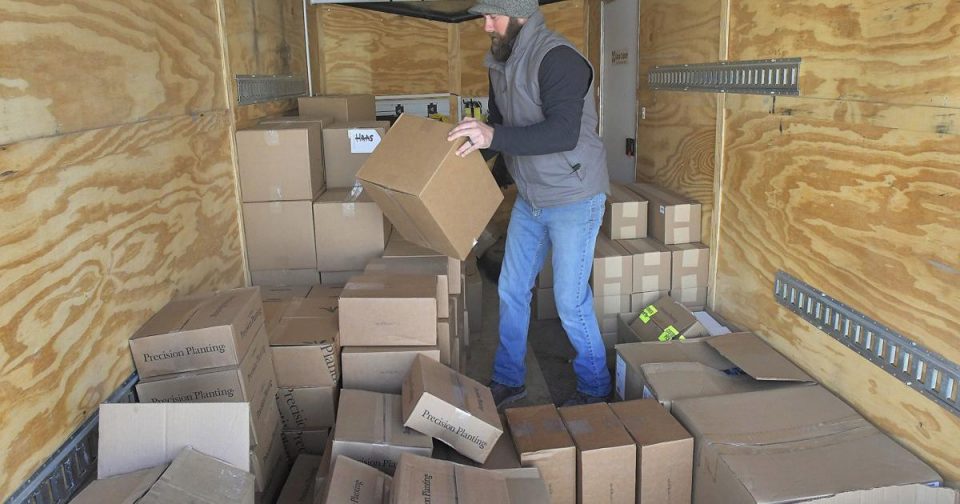Agriculture remains one of the area’s top businesses and supply chain and inflation issues present challenges.
BLOOMINGTON — When John Deere workers went on strike in October, some Central Illinois farmers worried about the ripple effect on the supply chain.
While workers returned to the job, those lingering concerns remain.
Downs farmer Brett Haas said he’s able to get the equipment he needs, “but there’s definitely not inventory on our dealer’s shelves that were accustomed to.”
The Deere strike, which involved about 10,000 workers of the Moline-based company, coincided with global distribution and transportation problems brought on by COVID-19. Supplies and goods from metal to fertilizer felt the impact.
Haas thinks the biggest culprit is the pandemic, but he said there are other factors at play. He said China shut down manufacturing facilities in advance of the upcoming Winter Olympics in Beijing. The South China Morning Post reported state authorities are closing production hubs to ensure blue skies for the internationally-attended event.
People are also reading…
It’s a moment of revelation for the Downs farmer.
Haas said: “It should open our eyes to what potentially could happen if we rely too heavily on other countries to produce our goods.”
What these challenges mean for Tom King, who runs a farm out of Merna, is he has to exhaust all avenues when sourcing mechanicals. He said that includes scouring auction sites, buying from retiring farmers, and getting dealer orders in early. People are also holding onto older equipment for a longer time, he said, meaning there are less trade-ins because it’s harder to buy new.
Downs-area farmer Brett Haas inventories the dozens of boxes of parts he will need to maintain planters and tractors that will be put to work during spring planting. Haas said some of the parts were delayed due to supply chain issues but expects to be up and running once weather conditions are good for planting.
King said the John Deere dealers are doing the best that they can do, and are pretty good at communicating where parts are at in their system. He also said John Deere holds “combine clinics,” where experts zero in on the machine’s wear-points and fix them ahead of a future breakdown.
However, that has to be done early. King said they’re pulling apparatus into the shop way in advance to give everyone enough time to get ready for the season.
“The farmer is helping the dealer, and you’re working together to try to help the supply chain issue,” he said. “It’s making us be more efficient.”
It’s the first time in his life he’s faced such a dilemma. Talking to a farmer senior to him, King was told it reminds them of war-time supply issues.
The way King remembers it, dealers used to order and customize equipment. In the past, he said they might have 10-20 planters on the lot.
Now, he said their lots are looking as empty as the auto dealers.
Haas said he hasn’t spoken with anyone who says they’ve been spared by the effects of supply chain shortages.
Downs area farmer Brett Haas steps out of a trailer of new parts that arrived at his farm, Tuesday, Jan. 18, 2022. Haas said some of the parts were delayed due to supply chain issues but expects to be up and running once weather conditions are good for planting.
“Where it’s groceries on the shelves at grocery stores or parts for a combine,” he said, “it’s affecting everybody.”
But it’s not just tractor and combine parts that are short on stock. Both farmers told a Lee Enterprises reporter that fertilizer prices have just about doubled.
When asked about those rates, Haas let out a nervous chuckle.
“We’re seeing record-high pricing really on all of our inputs,” Hass said. And that’s driven by two factors: supply and demand.
Haas said higher commodity prices are making some farmers consider getting into corn and soybeans, which by effect increases demands for fertilizer.
He said his operation was able to get the fertilizer he needed, but they had to pre-pay and submit orders months in advance. Haas had to do the same with crop protection products, like herbicides and fungicides.
With a few different products, he said it’s going to be impossible to get enough of what he typically needs.
So Haas said he has to adapt and find alternatives. But that’s a big adjustment for his operation.
Instead of using a mixture of three-four chemistry products for corn and soy, he said he’s developed different programs utilizing 7-8 chemicals that accomplish the same task.
But with most of the manufacturing based in China, he said there’s very little herbicide to go around this year.
That could be a big risk for his farm. Has said they’ll take a significant loss if they can’t keep fields clean and free of weeds.
It’s a lesson in scarcity for King.
He said: “We’re all being stewards of the land and working the hardest we can to raise the most on every acre, but there’s only so much to go around.
“Just thank God we have a good market right now and low interest rates.”
Illinois has some of the most valuable soil on earth. Fertilizers keep yields high. Now farmers are playing a crucial role in making sure our …
At the core of the Illinois Nutrient Loss Reduction Strategy is a trade-off between practicing typical agricultural methods and protecting aquatic ecosystems within Illinois and outside of the larger 31-state Mississippi River basin.
Farmer Jason Lay has a legacy to protect in his farm as he manages field runoff.
U.S. Secretary of Agriculture Tom Vilsack responds to a question about how the USDA can help municipalities that are working to ensure clean d…
Central Illinois reporters Kade Heather, Brenden Moore, Rob Stroud and Timothy Eggert are chronicling the impact of farm runoff on local ag pr…
Contact Brendan Denison at (309) 820-3238. Follow Brendan Denison on Twitter: @BrendanDenison



